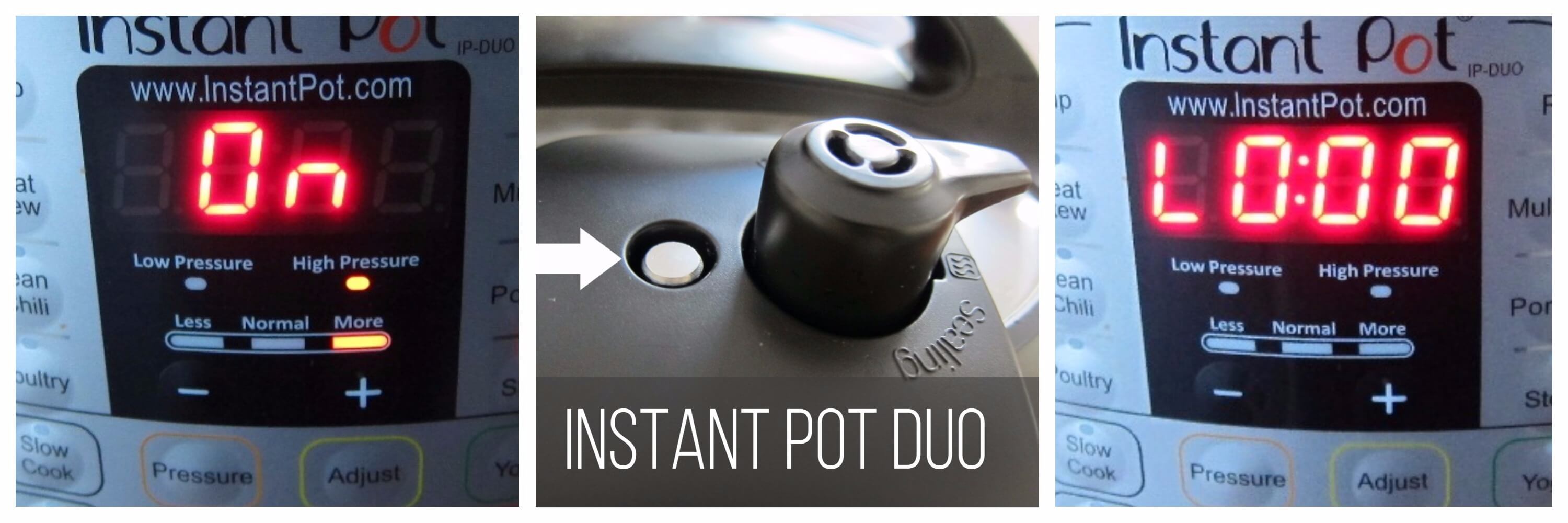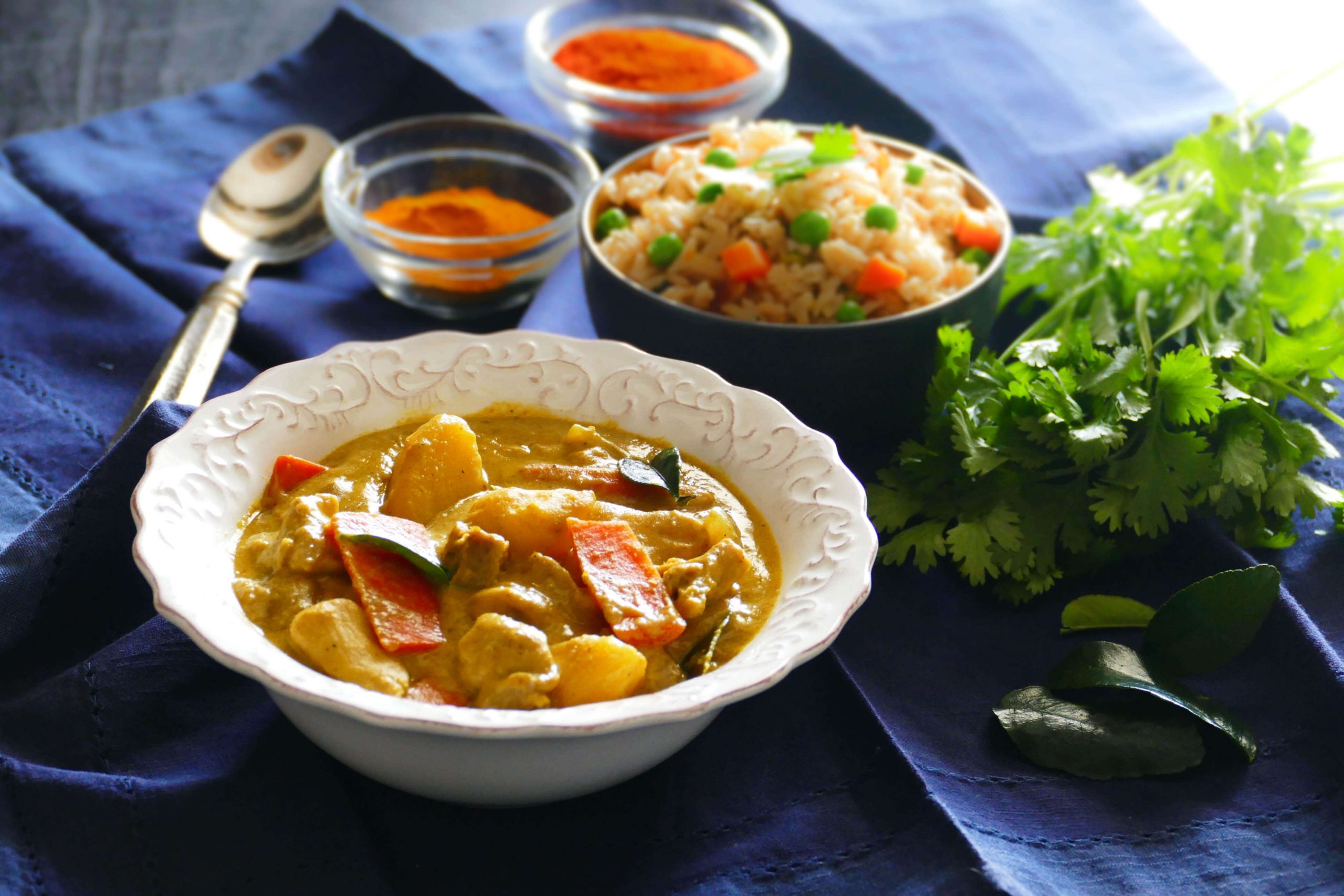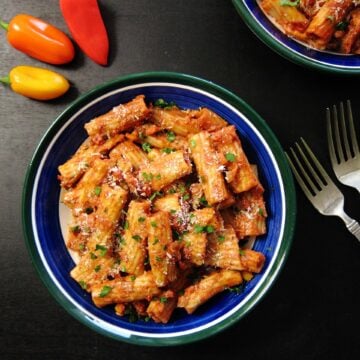This Instant Pot Panang Curry recipe tastes like it’s from a Thai restaurant! Creamy coconut milk, Panang curry paste, chicken, vegetables, and spices come together to make an amazingly tasty curry that is delicious served with jasmine rice. It’s a quick and easy recipe that you can make on a weeknight but it’s impressive enough to serve guests!

Serve this panang curry over Instant Pot jasmine rice, Instant Pot brown jasmine rice, or Instant Pot brown basmati rice.
This post contains affiliate links. As an Amazon Associate, I earn from qualifying purchases. Please read the disclosure.
Table of Contents
Introduction
It was a bit of a challenge to make this Panang curry in the Instant Pot and have it taste like the Thai Panang curries I order at restaurants.
Don’t get me wrong: it tasted great but tasted more like Thai Red Curry, which is quite delicious in its own right. I had to make the Panang curry numerous times, trying out different ingredients and quantities, until I finally perfected the recipe.
Learn more about your Instant Pot…
- Natural or Quick Release: What is Instant Pot natural release vs quick release and when should you use them?
- Instant Pot Tips and FAQs: What are Instant Pot frequently asked questions?
- Instant Pot Not Sealing: Why is your Instant Pot not sealing and what can you do to fix it?
- Common Instant Pot Problems: This Instant Pot troubleshooting guide explains common problems and errors and how to solve them.
- Sous Vide Button: How to use sous vide Instant Pot function for perfectly cooked foods.
The key to getting the Panang curry recipe right was to add an extra quantity of the ingredients that make it different from the red curry: coriander, cumin, and peanuts. I feel these flavors were lacking because pressure cooking toned down those flavors and made it seem like they weren’t even present.
A good Thai curry requires good-quality ingredients. You can read more about my quest to find the right ingredients for Thai curries on my Instant Pot Thai Red Curry recipe blog post.
Find out the difference between panang curry vs massaman curry.
This pressure cooker Panang Curry recipe can be made quickly and easily, even on a busy weeknight. I always keep coconut milk and curry paste in my pantry and I use whatever meat and vegetables I have on hand.
I find that Thai curries taste best with Jasmine rice rather than long grain, basmati, or even brown rice. Jasmine rice soaks up the curry and makes it taste so good!!
Here are some other super easy Thai recipes you’re going to love!
– Instant Pot Thai Red Curry
– Instant Pot Thai Green Curry
– Instant Pot Thai Massaman Curry
– Instant Pot Thai Yellow Curry
– Instant Pot Thai Grilled Chicken (Gai Yang)
– Instant Pot Thai Coconut Soup (Tom Kha Gai)
– Instant Pot Thai Peanut Noodles
– Instant Pot Jasmine Rice
[Read: Instant Pot Pot-in-Pot Cooking Method to learn how to cook rice and curry together!]
TIPS AND SUBSTITUTIONS
Panang Curry Paste
To make this curry taste like a restaurant-quality curry, you’ve got to get the right curry paste. There are two brands of Thai curry pastes that I really like: Maesri (which I like best) and Mae Ploy.
When I use Maesri, I use 3 tablespoons of paste, but with Mae Ploy, I use 2 tablespoons because I find it to be spicier. Adjust to your tastes. If the curry is too spicy at the end, add some more coconut milk when cooking the vegetables.
Lime Leaves
Lime leaves (also known as k-lime, makrut or kaffir lime leaves) add unique flavor to Thai curries.
You can find them at Asian grocery stores. I highly recommend using them. They keep very well in the freezer!
I like to either scrunch up the lime leaves and bruise them before adding them to the curry or chiffonade them by cutting them into very thin strips. This releases the oils from the leaves and adds a stronger flavor.
If you can’t find lime leaves, add an extra teaspoon or two of lime juice. Taste as you go.
Thai Basil
Thai basil is another ingredient you can find at an Asian grocery store. It, too, adds a unique flavor to Thai recipes and I recommend trying to find it. But if you can’t locate Thai basil, substitute with regular Italian basil.
Coconut Milk
I use full-fat coconut milk. I find some coconut milk brands don’t do well during pressure cooking, including some brands that are widely available at grocery stores. My two favorite brands are Aroy-D and Chaokoh. Some readers recommend Trader Joe’s brand coconut milk.
Fish Sauce
I really like the quality of Red Boat fish sauce which you can find at Asian grocery stores or on amazon. But it is more expensive than other fish sauce brands. Tiparos is another brand of fish sauce I’ve used – it’s more affordably priced.
There’s no substitute for fish sauce. It adds that depth of flavor, the umami, to dishes. I’ve had vegetarian readers recommend the Fysh brand of sauce. But I haven’t tried it. You may need to add a little extra.
Soy sauce is also a substitute for fish sauce, but there is a flavor difference.
Also note that Thai curries are generally eaten with rice. If you’re not planning on eating the curry with rice, you might need to adjust the salt by reducing the quantity of fish sauce.
Peanut Butter
Although you can grind up roasted peanuts into a paste, I choose to use store-bought peanut butter.
Palm Sugar
Palm sugar is more authentic to a Thai curry than brown sugar is. However, I frequently use brown sugar without sacrificing taste.
Vegetables
You don’t need to stick to the vegetables that I used. You can use any vegetables of your choice including zucchini, carrots, peas, bamboo shoots.
Meats
You can easily substitute other meats or tofu instead of chicken, but you’ll have to adjust the cooking time – here are some approximate times. The timing for meat is for bite-size strips!
- Pork shoulder: 8 minutes Natural Pressure Release (NPR)
- Beef chuck: 12 minutes NPR
- Extra-firm tofu, cubed: 2 minutes, Quick Release (QR)
Doubling the Recipe
You can double all the ingredients in the recipe and pressure cook for the same amount of time. Just make sure your ingredients don’t go past the ⅔-full mark.
Splatter Screen
When you’re sauteing ingredients in the Instant Pot, the bubbling mixture can splatter. I like to use a splatter screen to cover the inner pot during this saute process.
Burn Message
If you regularly encounter the ‘burn’ message, feel free to add ¼ cup of chicken broth when pressure cooking the coconut milk.
[Read more: Instant Pot Burn Message]
Instant Pot Panang Curry- Ingredients

- Onion
- Chicken
- Coconut milk
- Green beans (or any vegetable)
- Bell peppers
- Thai basil
- Lime leaves
- Cumin
- Coriander
- Fish sauce
- Peanut butter
- Brown sugar
- Lime juice
- Panang curry paste (missing from photo)
How to Make Thai Panang Curry in the Instant Pot (Step by Step Instructions)
- Turn on Saute Mode
- Saute coconut milk and spices
- Saute chicken
- Pressure cook
- Quick-release pressure
- Stir in vegetables and seasonings
How to Turn on Saute Mode

- Instant Pot DUO: Select the Saute function.
- Instant Pot ULTRA: Select the Saute function and press Start.
Saute Coconut Milk and Spices

- Stir together ½ can of coconut milk, Panang curry paste, cumin and coriander in the Instant Pot inner pot.
Saute Chicken

- Saute until mixture is bubbly and oil begins to separate, about two to three minutes. Use a splatter screen to prevent splatter, if necessary.
- Select ‘Cancel’ and stir in chicken and remaining coconut milk.
Instant Pot Duo Pressure Cook 4 minutes

- Close the lid and make sure steam release handle is in Sealing position
- Press Manual (or Pressure Cook) and + or – until the display reads 4 (4 minutes).
Instant Pot Ultra Pressure Cook 4 minutes

- Close the lid.
- Select Pressure Cook mode and adjust the time to 4 minutes (00:04).
- Press ‘Start’.
Pressure Cooking Process (Duo and Ultra)


- Instant Pot display will change to On.
- Once the Instant Pot is pressurized, the float valve will go up.
- The display will count down to 0; it will then switch to Keep Warm mode and display L0:00 or 00 00 and begin to count up the number of minutes since pressure cooking completed.
How to Quick Release Pressure (QR) on the DUO

- Move the steam release handle to Venting. Steam will come out of the steam release handle.
- When your Instant Pot is depressurized, the float valve will be in the down position.
- Press Cancel and open the Instant Pot.
How to Quick Release Pressure (QR) on the ULTRA

- Press down on the Steam Release Button until it locks into place, and steam begins to come out of the Steam Release Valve.
- When your Instant Pot is depressurized, the float valve will be in the down position.
- Press Cancel and open the Instant Pot.
[Find out more about the pressure release methods and how and when to use them. ]
Stir in Vegetables and Seasonings

- Select ‘Saute’ function.
- Stir in fish sauce, brown sugar, lime juice, peanut butter, bell pepper, green beans, onion, and lime leaves.
- Cook until vegetables are crisp-tender, about 3 to 5 minutes. Don’t overcook, as the vegetables will continue to cook in the residual heat.
- Taste and adjust with more fish sauce, brown sugar or lime juice.
- Stir in the Thai basil leaves.
- Serve with Instant Pot Jasmine Rice.
Instant Pot Tips and Tricks
Delay Start
Learn about how to use the Instant Pot Delay Start feature, which allows you to begin pressure cooking at a future time.
Pot in Pot
Find out how to use the Instant Pot pot in pot cooking method, which allows you to cook multiple foods together.
Cooking Times
Find out Instant Pot Cooking Times and what method of pressure release to use.
More Chicken Favorites
Love cooking chicken in the Instant Pot but looking for new recipes? Here are a few of my favorite Instant Pot chicken recipes that are easy, delicious, and fast to make.
- Instant Pot sous vide chicken breast
- Instant Pot chicken curry
- Instant Pot chicken shawarma
- Instant Pot Jamaican jerk chicken
For more chicken recipes, be sure to head over to my list of amazing Instant Pot chicken recipes you need to try!

Thai Instant Pot Panang Curry with Chicken
Ingredients
- 2 to 3 tablespoon Thai Panang curry paste preferably Maesri or Mae Ploy brand *
- 1 tsp coriander powder
- ½ tsp cumin powder
- 13.5 oz. coconut milk (400 ml) preferably Aroy D or Chaokoh brand
- 1 ½ lb boneless chicken breasts or thighs (⅔ kg) cut into bite-size pieces
- 2 Tbsp fish sauce more to taste
- 1 Tbsp brown sugar (or palm sugar), to taste
- 2 teaspoon lime juice
- 2 tablespoon peanut butter or to taste
- 1 cup red and/or green bell pepper sliced
- 1 cup green beans cut into 2-inch pieces
- ½ cup onion sliced
- 4 lime leaves slightly bruised **
- 12 to 15 Thai Basil leaves
Instructions
- Select Saute and stir together Panang curry paste, coriander, cumin and ½ can of coconut milk in the inner pot. until mixture is bubbly, about a minute or two.
- Press Cancel.
- Stir in chicken and remaining coconut milk.
- Close the lid and pressure cook on High Pressure for 4 minutes.
- Do a Quick Release of pressure and open the Instant Pot. [Read More: The Different Pressure Release Methods]
- Stir in fish sauce, brown sugar, lime juice, peanut butter, bell pepper, beans, onion, and lime leaves.
- Select Saute and cook until vegetables are crisp-tender, 3 to 5 minutes. (Be sure not to overcook. Vegetables will continue to cook in the residual heat.)
- Taste and adjust with more fish sauce, brown sugar, lime juice or peanut butter.
- Stir in the Thai basil leaves.
- Serve with Instant Pot Jasmine Rice.
Notes
- Prep time does not include steps that are already accounted for in the ingredient list, e.g. minced garlic, cut vegetables, etc.
- Use a splatter screen if necessary, to guard against the coconut milk bubbling up.
- Thai curries are generally eaten with rice. If you’re not planning on eating the curry with rice, you might need to adjust the salt by reducing the quantity of fish sauce.
- * I use 2 tablespoon of Mae Ploy brand or 3 tablespoon of Maesri brand.
- ** lime leaves also referred to as k-lime, makrut or kaffir lime leaves
- See the blog post for more detailed recipe tips.
Nutrition
Thank you for visiting Paint the Kitchen Red. All photos and content are copyright protected. Please don’t use any content without prior written permission. If you’ve made this recipe and would like to share it with your friends, please link back to this recipe. Thank you!
I am not a certified nutritionist. I provide my best estimate of nutritional information merely as a courtesy to my readers. If you depend on nutritional information for dietary or health reasons, I suggest using your favorite online nutrition calculator to confirm the nutritional value of this recipe based on the actual ingredients that you use.
Did you know that the best way to support your favorite bloggers is to comment and rate recipes, and share on social media? If you loved this recipe, please comment and give it a five ⭐ rating in the comment section below. If you’re a pinner, pin this post using the Pin buttons at the top and bottom of this post and in the recipe card above. Thank you for your support!
✅ Why Trust Neena at Paint the Kitchen Red?

I’m Neena, and I have a lifetime of experience working with pressure cookers. I know how to maximize the potential of a pressure cooker to consistently produce delicious and easy meals. With my Instant Pot expertise, I can provide valuable insights, troubleshooting advice, and innovative recipe ideas so you can trust me on all things Instant Pot!
➡ New to the Instant Pot? Get my Instant Pot instructions for beginners.
Recipes you Might Also Like!













Beth says
I can’t wait to make this — Panang curry is my favorite Thai dish. Do you use fresh limes to squeeze your own, or is any commercial variety okay? Since you were specific about your favorites for some of the other ingredients but not the lime juice, maybe the type doesn’t matter so much.
And I assume it’s red curry paste since Maesri comes in three “colors” in just our regular grocery store {shock!}.
Thanks — and I appreciate your clear instructions, notes plus the video! I don’t know what made me search on “instant pot panang curry,” but glad I found you.
Neena Panicker says
Hi Beth, welcome, and great question. I use bottled lime juice more often than fresh, and don’t notice a huge difference. You can definitely use the red curry paste but there is also a panang curry paste, which is what I use.
Beth says
Thanks so much! Given what I’ve read and that I’m a spice wimp, I’d be happier with the Panang. A nearby Asian market theoretically has the Maesri Panang. But the only Thai basil leaves found so far are frozen. I’ll keep searching/calling, but if that’s all that’s available, is it better to go with fresh basil leaves that’s aren’t Thai? Thanks again.
Signed,
Being Obsessive This First Try
Neena Panicker says
Hi Beth, don’t get frozen Thai basil – use Italian basil instead, it’s the better choice. But you can use frozen lime leaves. Good luck. I hope you like it. I just made this the other day for my daughter.
Beth says
Thanks again — and was surprised to see that a Wegmans often carries fresh Thai basil. I promised to make a crab/corn chowder tomorrow so the recipe after that will be your Panang curry and I’m sure it will be terrific.
And one last question (promise!). I usually order Panang curry with shrimp, and both Thai restaurants use jumbo shrimp. The jumbo shrimp I buy frozen and raw, and cooks in the Instant Pot in two minutes (just shrimp, lemon, water, Old Bay seasoning), though it takes a bit to come to pressure being frozen.
Would it be better to let it thaw and just toss it in at the end since shrimp cooks so quickly? The quality is excellent, but if it would be better to use frozen, precooked (and thaw it or toss it in at the end?). I may use chicken the first go round, though.
This is the most questions I’ve ever asked, yikes.
Neena Panicker says
Hi Beth, you could pressure cook the frozen shrimp as you would chicken (but for 2 minutes) and keep the rest of the recipe the same. I would give it a shot. I usually use thawed shrimp, in which case I make the whole recipe on the stovetop.